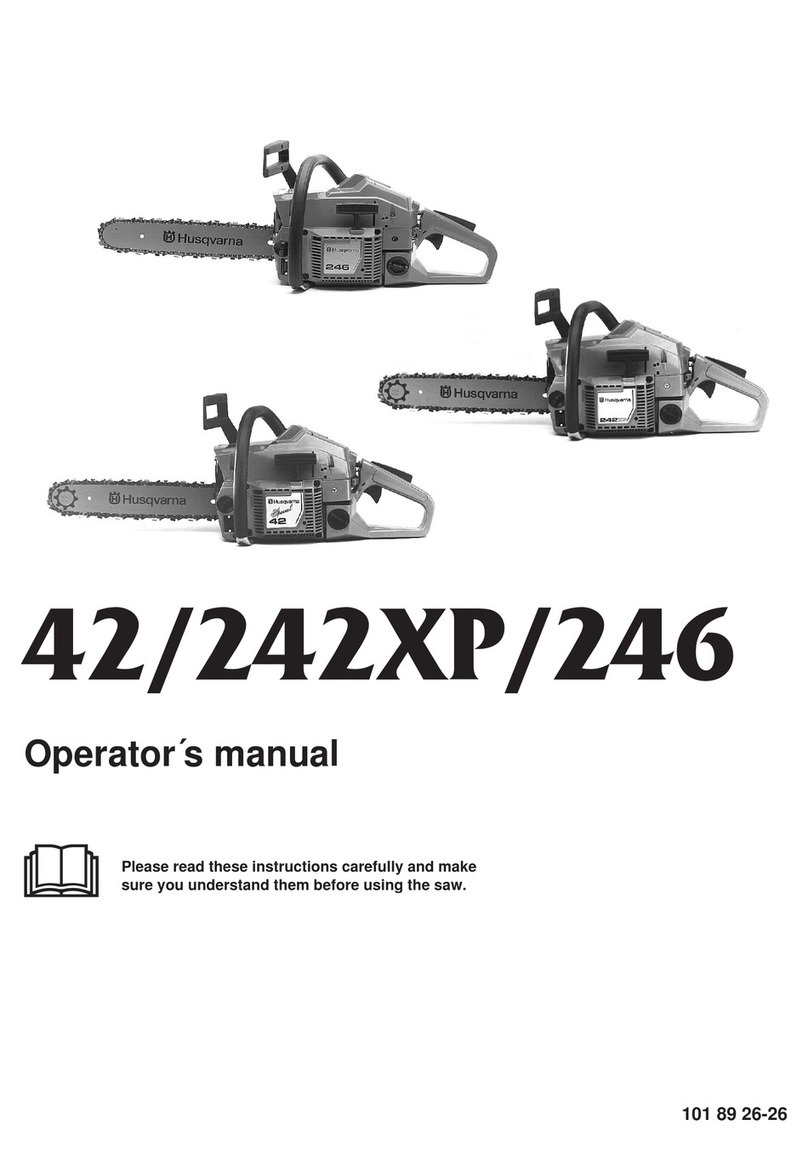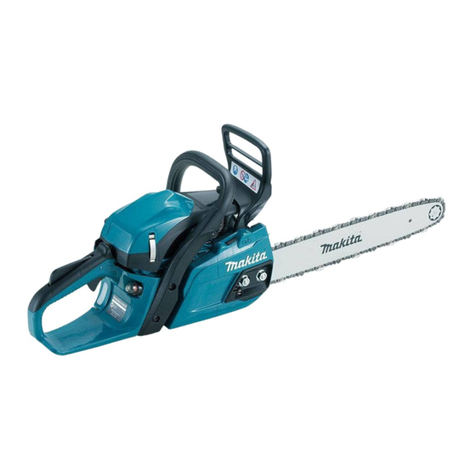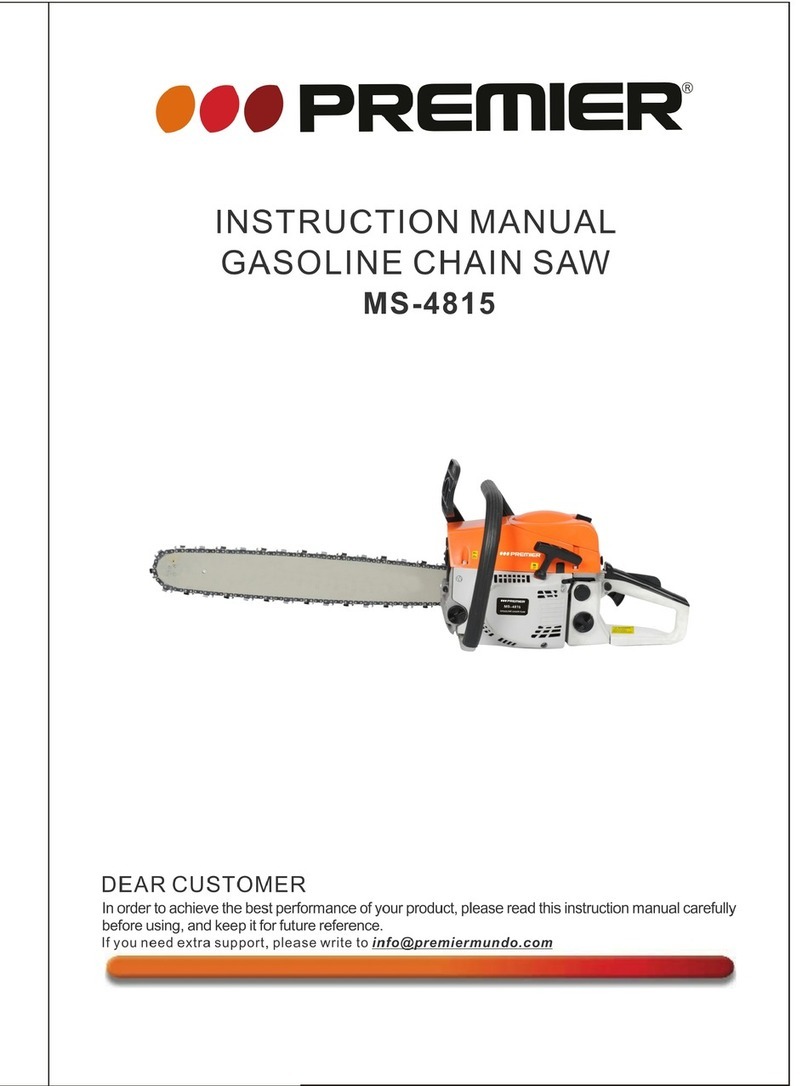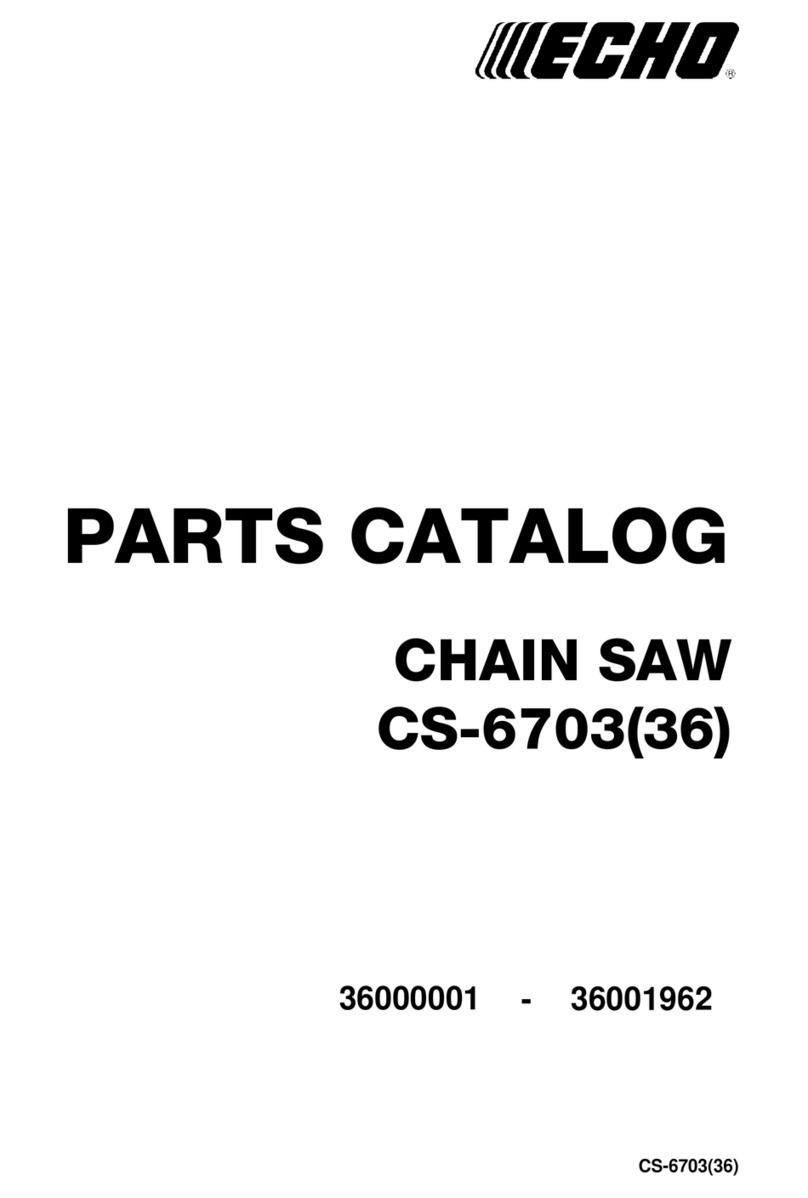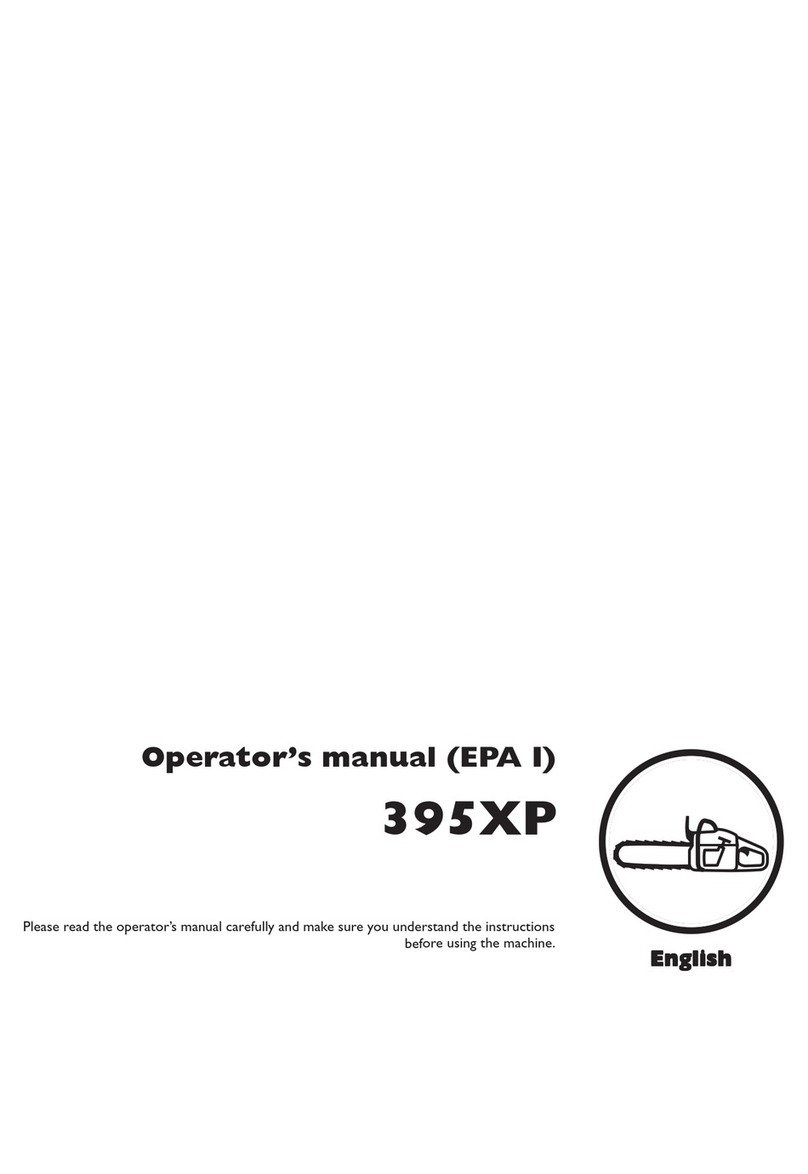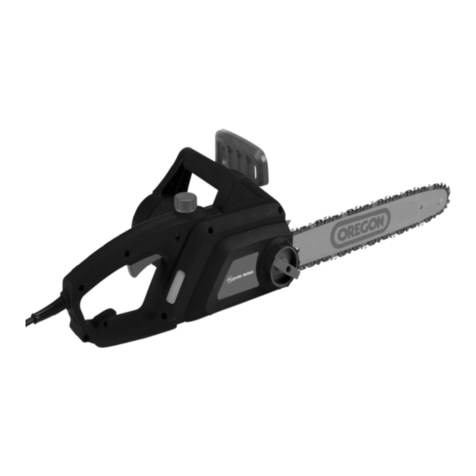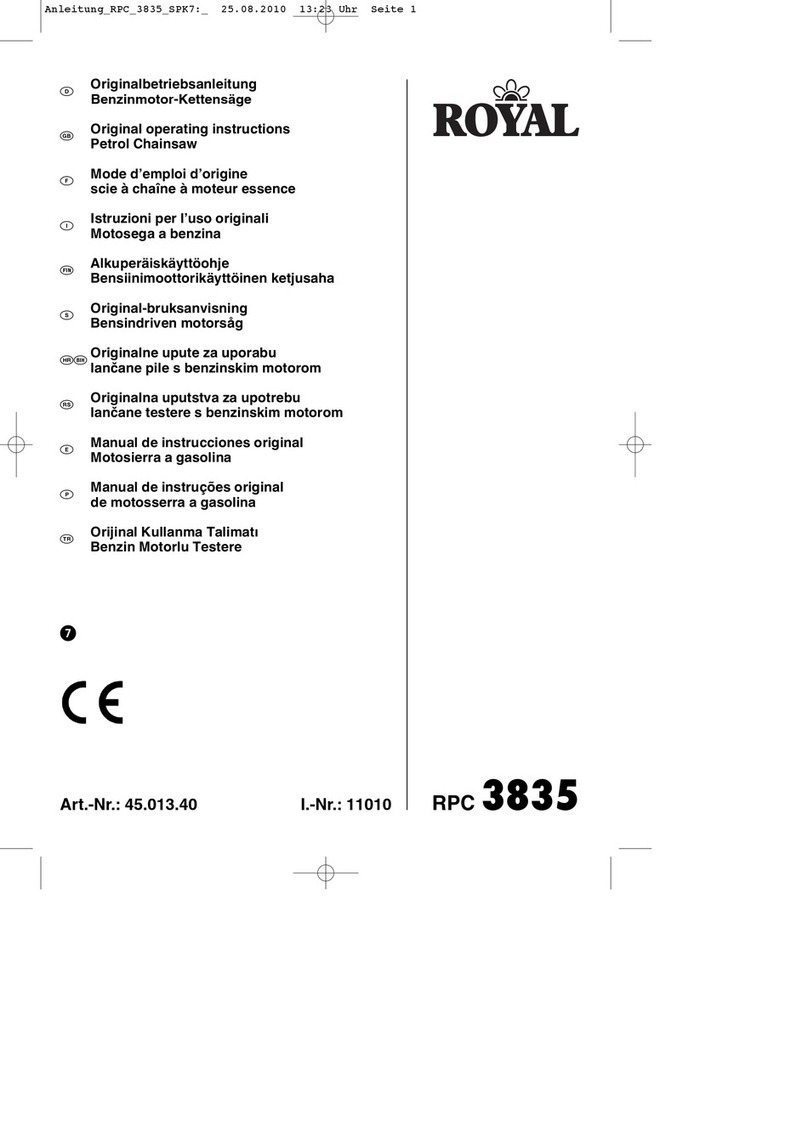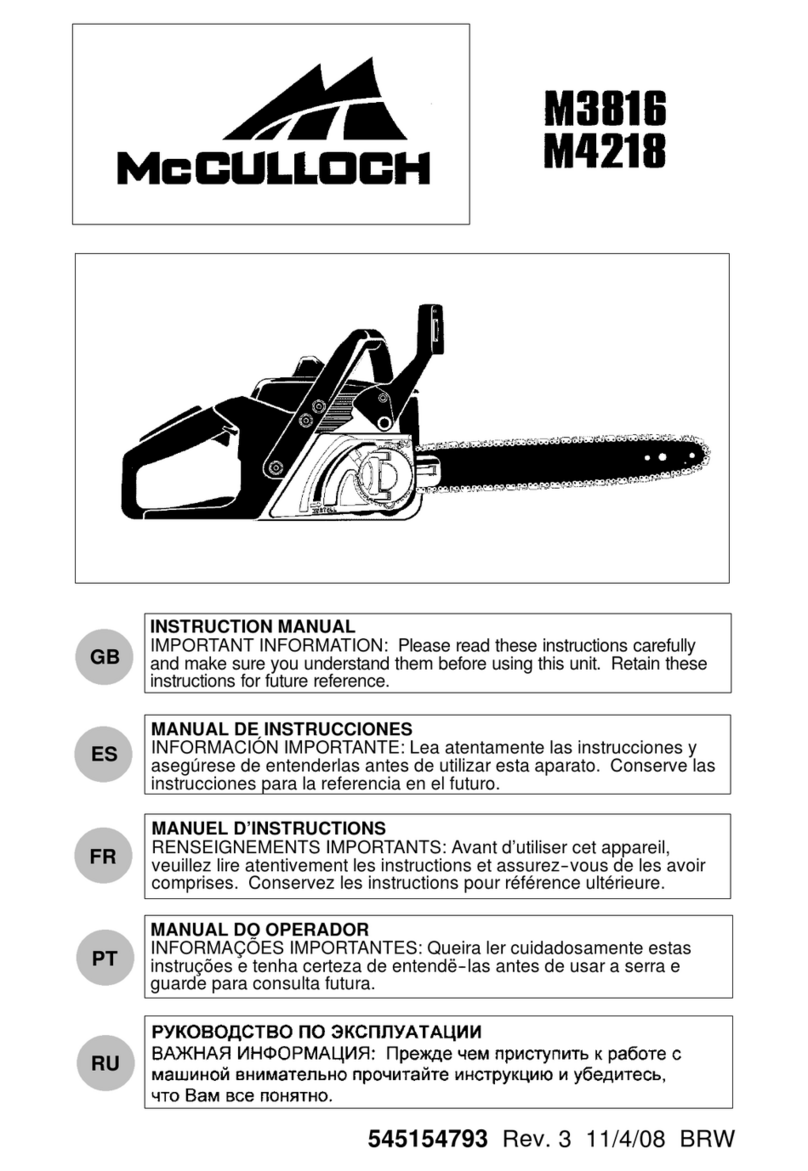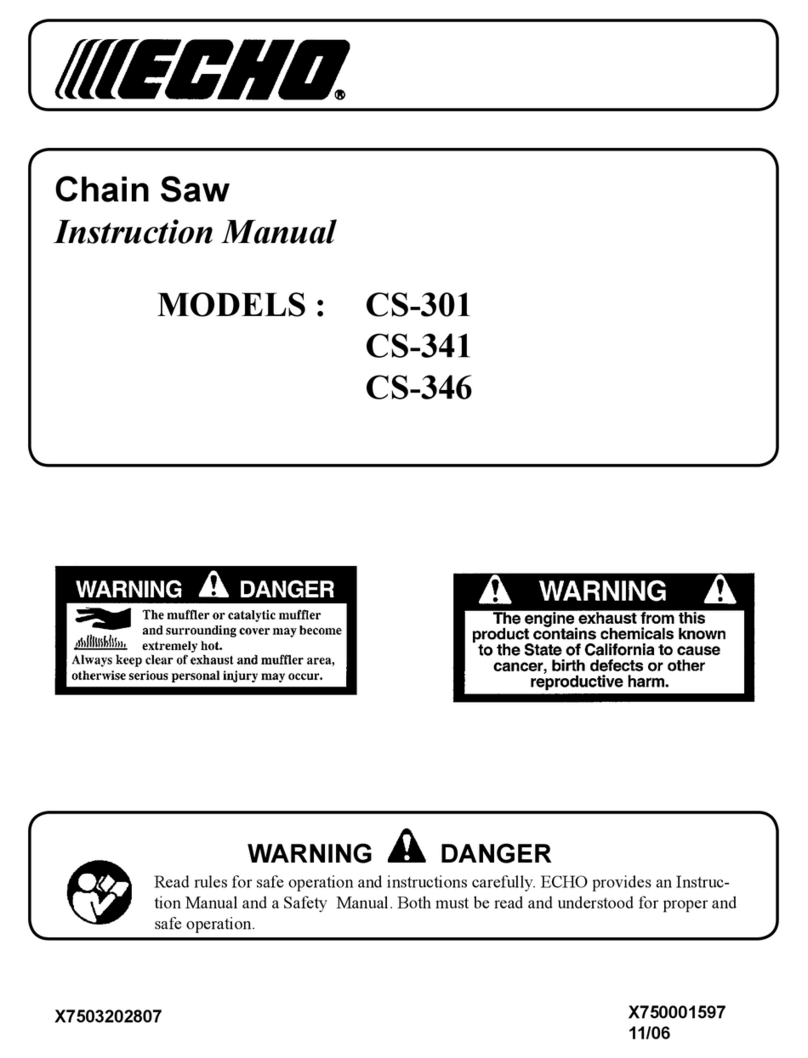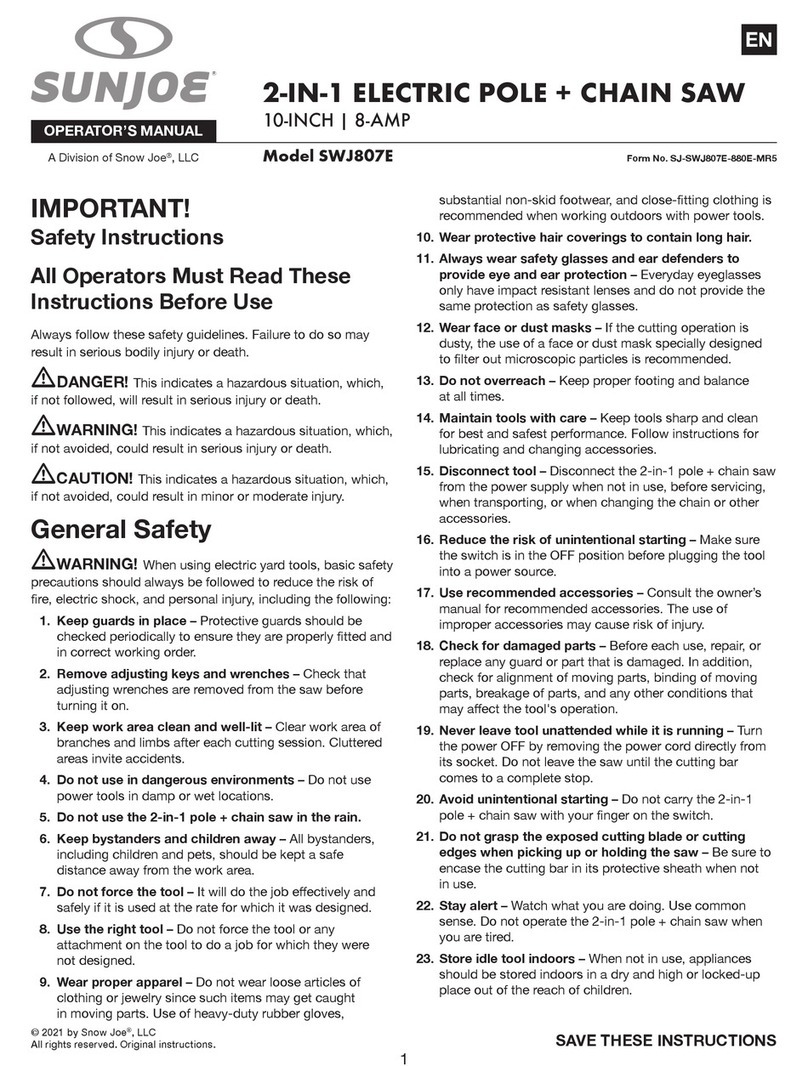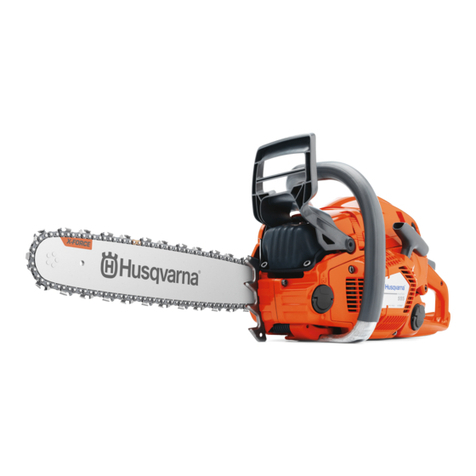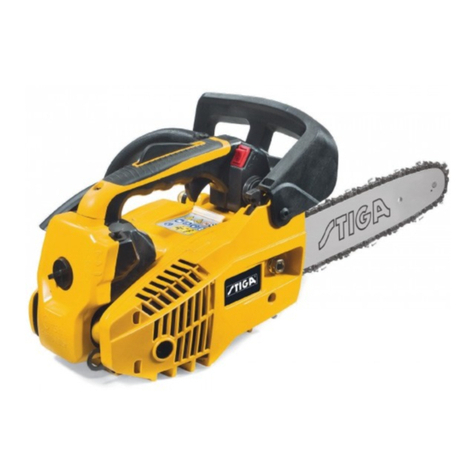RIDGID R01101 User manual

TABLE OF CONTENTS
General Power Tool Safety
Warnings ......................................... 2-3
Chainsaw Safety Warnings ............. 4-7
Symbols .......................................... 7-8
Glossary of Terms ...............................9
Features ............................................10
Assembly .................................... 10-11
Operation .................................... 11-16
Maintenance ............................... 16-19
Bar and Chain Combinations............20
Troubleshooting ................................20
Parts Ordering/Service........ Back Page
TABLE DES MATIÈRES
Avertissements règles de sécurité
relatives aux outils électriques........ 2-3
Avertissements de sécurité
relatifs au scie à chaîne................... 4-7
Symboles ........................................ 7-9
Glossaire ....................................... 9-10
Caractéristiques................................10
Assemblage ......................................11
Utilisation .................................... 11-16
Entretien...................................... 17-20
Combinaisons de guide et chaîne ....21
Dépannage........................................21
Commande de pièces/
réparation.......................... Páge arrière
ÍNDICE DE CONTENIDO
Advertencias de seguridad
para herramientas eléctricas........... 2-3
Advertencias de seguridad
de la motosierra .............................. 4-7
Símbolos ......................................... 7-9
Glosario de términos..................... 9-10
Características ............................ 10-11
Armado .............................................11
Funcionamiento .......................... 12-17
Mantenimiento ............................ 17-21
Combinaciones de barra y cadena...21
Correción de problemas ...................22
Pedidos de piezas/
servicio........................... Pág. posterior
To register your RIDGID product,
please visit: register.ridgidpower.com
Pour enregistrer votre produit
de RIDGID, s’il vous plaît la visite :
register.ridgidpower.com
Para registrar su producto
de RIDGID, por favor visita:
register.ridgidpower.com
OPERATOR’S MANUAL
Manuel de l’opérateur
Manual del operador
18V CHAINSAW
Scie à chaîne de 18 v
Motosierra de 18 v
R01101
WARNING:
To reduce the risk of injury, the
user must read and understand the
operator’s manual before using this
product.
AVERTISSEMENT :
Pour réduire les risques de blessures,
l’utilisateur doit lire et veiller à bien
comprendre le manuel d’utilisation
avant d’utiliser ce produit.
ADVERTENCIA:
Para reducir el riesgo de lesiones,
el usuario debe leer y comprender
el manual del operador antes de usar
este producto.
SAVE THIS MANUAL FOR
FUTURE REFERENCE
GUARDE ESTE MANUAL
PARA FUTURAS CONSULTAS
CONSERVER CE MANUEL
POUR FUTURE RÉFÉRENCE

i
Fig. 1
See this fold-out section for all of the figures referenced
in the operator’s manual.
Consulter l’encart à volets afin d’examiner toutes les figures
mentionnées dans le manuel d’utilisation.
Consulte esta sección desplegable para ver todas las figuras a
las que se hace referencia en el manual del operador.
A - Battery port (port du bloc-piles, puerto de batería)
B - Switch trigger (gâchette de commutateur, gatillo interruptor)
C - Rear handle (poignée arrière, mango trasero)
D - Lock-out button (bouton de verrouillage, botón de bloqueo)
E - Front handle (poignée avant,mango delantero)
F - Bar mounting nuts (écrou de montage du guide tuerca de montaje de la
barra)
G - Chain tensioning screw (vis de tension de la chaîne, tornillo tensor de la
cadena)
H - Hand guard/chain brake (protection de poignée avant /frein de chaîne,
protección delantera de la mano/ freno de la cadena
I - Chain (chaîne, cadena)
J - Scabbard (fourreau, funda)
K - Guide bar (guide de chaîne, barra guía)
L - Combination Wrench (clé mixte, llave de combinación)
M- Attachment hook (crochet de fixation,gancho de fijación)
N - Oil Tank (réservoir d’huile,tanque de aceite)
O - Spiked Bumper (pare-chocs spiked,protección en punta)
A
K
C
M
D
H
I
J
G
E
B
L
F
N
O

ii
tooltip
tooltip
A - Lock-out button (bouton de verrouillage, botón
de bloqueo)
B - Switch trigger (gâchette de commutateur,
gatillo del interruptor)
Fig. 5
Fig. 2
Fig. 3
Fig. 12
Fig. 13
Fig. 7
ROTATIONAL KICKBACK
REBOND ROTATIF
CONTRAGOLPE ROTATORIO
KICKBACK DANGER ZONE
ZONE DE DANGER DE REBOND
ZONA DE PELIGRO DE CONTRAGOLPE
PUSH
POUSSÉE
EMPUJÓN
Fig. 4
A - Battery pack (bloc-piles, paquete de baterías)
B - Battery port (logement de piles, receptáculo de
las baterías)
C - Latches (loquets, pestillos)
A - Chain oil tank cap (capuchon du réservoir
d’huile de chaîne, tapa del tanque del aceite de
la cadena )
CHAIN LINE
LIGNE DE CHAÎNE
PLANO DE LA CADENA
CORRECT
CORRECT
CORRECTO
1
Fig. 8
Fig. 9
Fig. 10
Fig. 11
INCORRECT
INCORRECTE
INCORRECTO
PULL
TIRAGE
TIRÓN
2
Fig. 6
A
A
B
C
B
A
BRAKE POSITION
FREIN ENGAGÉ
POSICIÓN DE FRENADO
RUN POSITION
POSITION DE MARCHE
POSICIÓN DE
FUNCIONAMIENTO

iii
HINGE 2 in. OR 1/10 DIA
CHARNIÈRE, 51 mm (2 po) OU 1/10 ÈME DU DIAMÈTRE
BISAGRA 51 mm (2 pulg.) Ó 1/10 DEL DIÁM.
NOTCH – APPROX. 1/3
DIAMETER OF TRUNK
SIFFLET - ENVIRON 1/3
DU DIAMÈTRE DU TRONC
MUESCA - APROX. 1/3
DEL DIÁMETRO DEL
TRONCO
BACK CUT 2 in.
ENTAILLE ARRIÈRE
DE 51 mm [2 po]
CORTE TRASERO 51
mm (2 pulg.)
45°
45°
RETREAT PATH
RETREAT PATH
Fig. 16
Fig. 17
Fig. 20
Fig. 21
KICKBACK
REBOND
CONTRAGOLPE
A - Chain line (ligne de chaîne, plano de la cadena)
B - Straight arm position (bras tendu, posición con el brazo recto)
Fig. 14
Fig. 15
AB
A - Back cut (entaille d’abattage, corte trasero)
B - Notch (encoche, muesca)
C - Hinge charnière, bisagra)
A - Wedge (coin, cuña)
Fig. 18
Fig. 19
C
B
A
A
A
B
B
A - Planned line of fall (ligne de chute prévue,
Línea de caída planificada)
B - Retreat path (chemin de retraite, camino de
retirada)

iv
Fig. 25
Fig. 26
A - Overbucking (coupe par le dessus, tronzado por
arriba)
B - Underbucking (coupe par le dessous, tronzado
por abajo)
A - Chain tensioning screw (vis de tension
de la chaîne, tornillo tensor de la cadena)
B - Bar mounting nuts (écrou de montage du
guide tuerca de montaje de la barra)
A - Bar stud (goujon du guide, perno de montaje de
la barra)
B - Chain tension pin hole (orifice de broche de
tension de chaîne, pasador de tensado de la
cadena)
C - Adjusting pin (broche de réglage de tension de
chaîne,pasador deajuste)
D - Chain cover (carter de la chaîne, tapa de la
cadena)
E - Bar mounting nuts (écrou de montage du guide
tuerca de montaje de la barra)
A - Cutters (dents, dientes de corte)
B - Chain rotation (rotation de la chaîne, avance de
la cadena)
C - Chain drive links (maillons d’entraînement,
eslabones de impulsión de la cadena)
A - Bar groove (rainure du guide, ranura de la barra
B - Chain drive links (maillons d’entraînement,
eslabones de impulsión de la cadena)
A - Load (charge, carga)
B - Second cut (deuxième coupe, segundo corte)
C - First cut - 1/3 diameter (première coupe 1/3 du
diamètre, primer corte 1/3 del diámetro)
D - Finishing cut (coupe de finition, corte final)
A - Springpole (fouet, pértiga)
A
A
A
B
CD
CUT LIMBS ONE AT A TIME AND LEAVE SUPPORT
LIMBS UNDER TREE UNTIL LOG IS CUT
COUPER LES BRANCHES UNE À UNE ET LAISSER
CELLES SOUTENANT LE TRONC JUSQU’À CE QU
CELUI-CI SOIT DÉBITÉ
CORTE UNA RAMA A LA VEZ Y DEJE RAMAS DE
SOPORTE BAJO EL ÁRBOL HASTA QUE ESTÉ
CORTADO EL TRONCO
4
13
2
Fig. 23
Fig. 24
Fig. 27
Fig. 31
Fig. 28
Fig. 29
Fig. 30
B
A
A
A
C
B
E
B
C
D
BA
B
A
E
B
C
D
A - Mounting surface (barre de leur support,
superficie de montaje)
B - Chain (chaîne, cadena)
C - Bar (barre,barra)
D - Chain cover (carter de la chaîne, tapa de la
cadena)
E - Bar mounting nuts (écrou de montage du guide
tuerca de montaje de la barra)
A - Load (charge, carga)
B - 1st cut - 1/3 diameter (1ère coupe 1/3 diam,
primer corte, 1/3 del diám.)
C - Finishing cut (coupe de finition, corte final)
Fig. 22 LOG SUPPORTED AT ONE END:
BILLE SOUTENUE À UNE EXTRÉMITÉ :
TRONCO APOYADO POR UN EXTREMO :
LOG SUPPORTED AT BOTH ENDS:
BILLE SOUTENUE AUX DEUX EXTRÉMITÉS :
TRONCO APOYADO POR AMBOS EXTREMOS :
A
AB
B
C
C

v
A - Drive sprocket (pignon d’entraînement, Rueda dentada de impulsión)
B - Check for wear or damage (s’assurer de l’absence d’usure ou de dommages,
revise para ver si hay desgaste o daños)
Fig. 39
Fig. 36
Fig. 35
Fig. 34 Fig. 38
RAKER CLEARANCE .025 IN.
JEU DU LIMITEUR 0,6 MM (0,025 PO)
ESPACIO LIBRE DE LOS DIENTES LIMPIADORES 0,025 MM (0,6 PULG.)
A
B
C
D
E
F
G
H
APPROX. .050 in.
≈1,25 mm (0,050 po)
≈1,25 mm (0,050 pulg.)
≈ 0.050 in.
≈ 1,27 mm (0,050 po)
≈ 1,27 mm (0,050 pulg.)
A - Top plate (plaque supérieure, placa superior)
B - Cutting Corner (coupe de coin, esquina de corte)
C - Side plate (plaque latérale, placa lateral)
D - Depth gauge (limiteur de profondeur, calibre de profundidad)
E - Toe (sabot, puntera)
F - Gullet (creux, garganta)
G - Heel (talon, talón)
H - Rivet hole (trou de rivet, orificio del remache)
A - Flats on tie straps (parties plates sur les liens de traverse, partes planas de
los amarres)
A
A
B
Fig. 37
A - Chain tensioning screw (vis de tension de la chaîne, tornillo tensor de la
cadena)
B - Bar mounting nuts (écrou de montage du guide tuerca de montaje de la
barra)
Fig. 32 LIFT THE TIP OF THE GUIDE BAR UP TO CHECK FOR SAG
RELEVER L’EXTRÉMITÉ DU GUIDE POUR VÉRIFIER LE MOU
LEVANTE LA PUNTA DE LA BARRA GUÍA PARA REVISAR LA HOLGURA
DE LA CADENA
Fig. 33
B
A
Combination Wrench (clé mixte, llave de combinación)

vi
INCORRECT SIDE PLATE FILING ANGLE
ANGLE D’AFFÛTAGE DE LA PLAQUE LATÉRALE
INCORRECT
ÁNGULO INCORRECTO DE LIMADURA DE LA
PLACA LATERAL
BACKWARD SLOPE
ANGLE ARRIÈRE
PENDIENTE HACIA ATRÁS
HOOK
CROCHET
GANCHO
80°
CORRECT SIDE PLATE
FILING ANGLE
ANGLE D’AFFÛTAGE DE
LA PLAQUE LATÉRALE
CORRECT
ÁNGULO CORRECTO DE
LIMADURA DE LA PLACA
LATERAL
B
A
A
RESTORE ORIGINAL SHAPE BY
ROUNDING THE FRONT
RENDRE LA FORME D’ORIGINE EN
ARRONDISSANT L’AVANT
RESTABLEZCA LA FORMA
ORIGINAL REDONDEANDO LA
PARTE FRONTAL
Fig. 46
Fig. 42
Fig. 43
Fig. 44
Fig. 45
A
A - Lubricating hole (trou de lubrification, orificio de lubricación)
A - Scabbard (fourreau, funda)
A - Depth gauge jointer (coupleur de limiteur de profondeur, igualador de
calibres de profundidad)
B - Flate file (lime plate, lima plana)
INCORRECT TOP PLATE FILING ANGLE
ANGLE D’AFFÛTAGE DE LA PLAQUE
SUPÉRIEURE INCORRECT
ÁNGULO INCORRECTO DE LIMADURA DE
LA PLACA SUPERIOR
MORE THAN 30°
PLUS DE 30°
MÁS DE 30°
LESS THAN 30°
MOINS DE 30°
MENOS DE 30°
30°
CORRECT TOP PLATE FILING
ANGLE
ANGLE D’AFFÛTAGE DE
LA PLAQUE SUPÉRIEURE
CORRECT
ÁNGULO CORRECTO DE
LIMADURA DE LA PLACA
SUPERIOR
Fig. 41
Fig. 40
A - Left hand cutters (dents de droite, dientes de corte izquierdos)
B - Right hand cutters (dents de gauche, dientes de corte derechos)
AB

2 — English
GENERAL POWER TOOL SAFETY WARNINGS
WARNING:
Read all safety warnings, instructions, illus-
trations and specifications provided with this
power tool. Failure to follow all instructions listed
below may result in electric shock, fire and/or
serious injury.
Save all warnings and instructions for future reference.
The term “power tool” in the warnings refers to your mains-
operated (corded) power tool or battery-operated (cordless)
power tool.
WORK AREA SAFETY
Keep work area clean and well lit. Cluttered or dark
areas invite accidents.
Do not operate power tools in explosive atmospheres,
such as in the presence of flammable liquids, gases
or dust. Power tools create sparks which may ignite the
dust or fumes.
Keep children and bystanders away while operating a
power tool. Distractions can cause you to lose control.
ELECTRICAL SAFETY
Power tool plugs must match the outlet. Never modify
the plug in any way. Do not use any adapter plugs with
earthed (grounded) power tools. Unmodified plugs and
matching outlets will reduce risk of electric shock.
Avoid body contact with earthed or grounded surfaces
such as pipes, radiators, ranges and refrigerators.
There is an increased risk of electric shock if your body
is earthed or grounded.
Do not expose power tools to rain or wet conditions.
Water entering a power tool will increase the risk of elec-
tric shock.
Do not abuse the cord. Never use the cord for carrying,
pulling or unplugging the power tool. Keep cord away
from heat, oil, sharp edges or moving parts. Damaged
or entangled cords increase the risk of electric shock.
When operating a power tool outdoors, use an exten-
sion cord suitable for outdoor use. Use of a cord suit-
able for outdoor use reduces the risk of electric shock.
If operating a power tool in a damp location is un-
avoidable, use a ground fault circuit interrupter (GFCI)
protected supply. Use of a GFCI reduces the risk of
electric shock.
PERSONAL SAFETY
Stay alert, watch what you are doing and use com-
mon sense when operating a power tool. Do not use
a power tool while you are tired or under the influence
of drugs, alcohol or medication. A moment of inatten-
tion while operating power tools may result in serious
personal injury.
Use personal protective equipment. Always wear eye
protection. Protective equipment such as dust mask,
non-skid safety shoes, hard hat, or hearing protection
used for appropriate conditions will reduce personal
injuries.
Prevent unintentional starting. Ensure the switch is in
the off-position before connecting to power source
and/or battery pack, picking up or carrying the tool.
Carrying power tools with your finger on the switch or
energising power tools that have the switch on invites
accidents.
Remove any adjusting key or wrench before turning
the power tool on. A wrench or a key left attached to
a rotating part of the power tool may result in personal
injury.
Do not overreach. Keep proper footing and balance
at all times. This enables better control of the power tool
in unexpected situations.
Dress properly. Do not wear loose clothing or jewel-
lery. Keep your hair, clothing and gloves away from
moving parts. Loose clothes, jewellery or long hair can
be caught in moving parts.
If devices are provided for the connection of dust
extraction and collection facilities, ensure these are
connected and properly used. Use of dust collection
can reduce dust-related hazards.
Do not let familiarity gained from frequent use of tools
allow you to become complacent and ignore tool
safety principles. A careless action can cause severe
injury within a fraction of a second.

3 — English
GENERAL POWER TOOL SAFETY WARNINGS
POWER TOOL USE AND CARE
Do not force the power tool. Use the correct power
tool for your application. The correct power tool will
do the job better and safer at the rate for which it was
designed.
Do not use the power tool if the switch does not turn
it on and off. Any power tool that cannot be controlled
with the switch is dangerous and must be repaired.
Disconnect the plug from the power source and/or
the battery pack from the power tool before making
any adjustments, changing accessories, or storing
power tools. Such preventive safety measures reduce
the risk of starting the power tool accidentally.
Store idle power tools out of the reach of children and
do not allow persons unfamiliar with the power tool
or these instructions to operate the power tool. Power
tools are dangerous in the hands of untrained users.
Maintain power tools. Check for misalignment or bind-
ing of moving parts, breakage of parts and any other
condition that may affect the power tool’s operation.
If damaged, have the power tool repaired before use.
Many accidents are caused by poorly maintained power
tools.
Keep cutting tools sharp and clean. Properly main-
tained cutting tools with sharp cutting edges are less
likely to bind and are easier to control.
Use the power tool, accessories and tool bits etc.
in accordance with these instructions, taking into
account the working conditions and the work to be
performed. Use of the power tool for operations different
from those intended could result in a hazardous situation.
Keep handles and grasping surfaces dry, clean and
free from oil and grease. Slippery handles and grasping
surfaces do not allow for safe handling and control of the
tool in unexpected situations.
BATTERY TOOL USE AND CARE
Recharge only with the charger specified by the
manufacturer. A charger that is suitable for one type
of battery pack may create a risk of fire when used with
another battery pack.
Use power tools only with specifically designated bat-
tery packs. Use of any other battery packs may create
a risk of injury and fire.
When battery pack is not in use, keep it away from
other metal objects, like paper clips, coins, keys, nails,
screws or other small metal objects, that can make a
connection from one terminal to another. Shorting the
battery terminals together may cause burns or a fire.
Under abusive conditions, liquid may be ejected from
the battery; avoid contact. If contact accidentally
occurs, flush with water. If liquid contacts eyes, ad-
ditionally seek medical help. Liquid ejected from the
battery may cause irritation or burns.
Do not use a battery pack or tool that is damaged or
modified. Damaged or modified batteries may exhibit
unpredictable behaviour resulting in fire, explosion or risk
of injury.
Do not expose a battery pack or tool to fire or exces-
sive temperature. Exposure to fire or temperature above
265°F may cause explosion.
Follow all charging instructions and do not charge the
battery pack or tool outside the temperature range
specified in the instructions. Charging improperly or at
temperatures outside the specified range may damage
the battery and increase the risk of fire.
SERVICE
Have your power tool serviced by a qualified repair
person using only identical replacement parts. This will
ensure that the safety of the power tool is maintained.
Never service damaged battery packs. Service of bat-
tery packs should only be performed by the manufacturer
or authorized service providers.
When servicing a power tool, use only identical re-
placement parts. Follow instructions in the Mainte-
nance section of this manual. Use of unauthorized parts
or failure to follow maintenance instructions may create
a risk of shock or injury.

4 — English
CHAINSAW SAFETY WARNINGS
Keep all parts of the body away from the saw chain
when the chainsaw is operating. Before you start the
chainsaw, make sure the saw chain is not contact-
ing anything. A moment of inattention while operating
chainsaws may cause entanglement of your clothing or
body with the saw chain.
Always hold the chainsaw with your right hand on the
rear handle and your left hand on the front handle.
Holding the chainsaw with a reversed hand configuration
increases the risk of personal injury and should never be
done.
Hold the power tool by insulated gripping surfaces
only, because the saw chain may contact hidden
wiring. Saw chains contacting a “live” wire may make
exposed metal parts of the power tool “live” and could
give the operator an electric shock.
Wear eye protection. Further protective equipment for
hearing, head, hands, legs and feet is recommended.
Adequate protective equipment will reduce personal in-
jury from flying debris or accidental contact with the saw
chain.
Do not operate a chainsaw, on a ladder, from a rooftop,
or any unstable support. Operation of a chainsaw in this
manner could result in serious personal injury.
NOTE: The size of the work area depends on the job
being performed as well as the size tree or work piece
involved. For example, felling a tree requires a larger work
area than making bucking cuts.
Do not operate a chainsaw in a tree unless you have
been specifically trained to do so. Operation of a chain-
saw in a tree without proper training could increase the
risk of serious personal injury.
Always keep proper footing and operate the chainsaw
only when standing on fixed, secure and level surface.
Slippery or unstable surfaces such as ladders may cause
a loss of balance or control of the chainsaw.
When cutting a limb that is under tension be alert
for spring back. When the tension in the wood fibres is
released the spring loaded limb may strike the operator
and/or throw the chainsaw out of control.
Use extreme caution when cutting brush and saplings.
The slender material may catch the saw chain and be
whipped toward you or pull you off balance.
Follow all instructions when clearing jammed mate-
rial, storing or servicing the chainsaw. Make sure the
switch is off and the battery pack is removed. Unex-
pected actuation of the chainsaw while clearing jammed
material or servicing may result in serious personal injury.
Carry the chainsaw by the front handle with the chain-
saw switched off and away from your body. When
transporting or storing the chainsaw always fit the
scabbard. Proper handling of the chainsaw will reduce
the likelihood of accidental contact with the moving saw
chain.
Follow instructions for lubricating, chain tensioning
and changing the bar and chain. Improperly tensioned
or lubricated chain may either break or increase the
chance for kickback.
Cut wood only. Do not use chainsaw for purposes not
intended. For example: do not use chainsaw for cut-
ting plastic, masonry or non-wood building materials.
Use of the chainsaw for operations different than intended
could result in a hazardous situation.
Do not attempt to fell a tree until you have an under-
standing of the risks and how to avoid them. Serious
injury could occur to the operator or bystanders while
felling a tree.
CAUSES AND OPERATOR PREVENTION OF
KICKBACK
Kickback may occur when the nose or tip of the guide bar
touches an object, or when the wood closes in and pinches
the saw chain in the cut.
Tip contact in some cases may cause a sudden reverse reac-
tion, kicking the guide bar up and back towards the operator.
Pinching the saw chain along the top of the guide bar may
push the guide bar rapidly back towards the operator.
Either of these reactions may cause you to lose control of
the saw which could result in serious personal injury. Do not
rely exclusively upon the safety devices built into your saw.
As a chainsaw user, you should take several steps to keep
your cutting jobs free from accident or injury.
Kickback is the result of tool misuse and/or incorrect operat-
ing procedures or conditions and can be avoided by taking
proper precautions as given below:
Maintain a firm grip, with thumbs and fingers encir-
cling the chainsaw handles, with both hands on the
saw and position your body and arm to allow you to
resist kickback forces. Kickback forces can be con-
trolled by the operator, if proper precautions are taken.
Do not let go of the chainsaw.
Do not overreach and do not cut above chest height.
This helps prevent unintended tip contact and enables
better control of the chainsaw in unexpected situations.
Only use replacement bars and chains specified by
the manufacturer. Incorrect replacement bars and chains
may cause chain breakage and/or kickback.

5 — English
CHAINSAW SAFETY WARNINGS
Follow the manufacturer’s sharpening and mainte-
nance instructions for the saw chain. Decreasing the
depth gauge height can lead to increased kickback.
Do not start cutting until you have a clear work area, se-
cure footing, and a planned retreat path from the falling
tree. Cluttered areas invite accidents.
Keep ALL children, bystanders, visitors, and animals out
of the work area while starting or cutting with the chain-
saw. Do not let visitors contact chainsaw or extension
cord.
Do not operate chainsaw in explosive atmospheres, such
as in the presence of flammable liquids, gases, or dust.
Chainsaws create sparks which may ignite the dust or
fumes.
Dress Properly – Wear snug fitting clothing. Always wear
heavy, long pants, long sleeves, overalls, jeans or chaps
made of cut resistant material or ones that contain cut
resistant inserts. Wear non-slip safety footwear. Wear
non-slip heavy duty gloves to improve your grip and to
protect your hands. Do not wear jewelry, short pants,
sandals, or go barefoot. Do not wear loose fitting clothing,
which could be drawn into the motor or catch the chain
or underbrush. Secure hair so it is above shoulder level.
Wear hearing and head protection.
Heavy protective clothing may increase operator fatigue,
which could lead to heat stroke. During weather that is
hot and humid, heavy work should be scheduled for early
morning or late afternoon hours when temperatures are
cooler.
Always wear eye protection with side shields marked
to comply with ANSI Z87.1 as well as hearing and head
protection when operating this equipment.
Always be aware of what you are doing when using the
chainsaw. Use common sense. Do not operate the chain-
saw when you are tired, ill, upset, or under the influence
of alcohol, drugs, or medication.
Do not expose the chainsaw to rain.
Do not use the chainsaw in damp or wet locations.
Stay alert and pay attention to what you are doing. Use
common sense when using this unit.
Keep all parts of your body away from the saw chain when
the unit is running.
Never let anyone use your chainsaw who has not received
adequate instructions in its proper use. This applies to
rentals as well as privately owned saws.
Before you start the unit, make sure the saw chain is not
contacting any object.
Stop the chainsaw before setting it down.
To avoid accidental starting, never carry the unit with your
finger on the switch trigger.
Maintain the unit with care. Keep the cutting edge sharp
and clean for best performance and to reduce the risk
of injury. Follow instructions for lubricating and changing
accessories.
Do not operate a chainsaw with one hand! Use a firm grip
with thumbs and fingers encircling the chainsaw handles.
Serious injury to the operator, helpers, bystanders, or
any combination of these persons may result from one-
handed operation. A chainsaw is intended for two-handed
use.
Guard against electric shock – Avoid body contact with
grounded surfaces such as metal pipes and wire fences.
There is an increased risk of electric shock if your body
is grounded.
Do not operate a chainsaw that is damaged, improperly
adjusted, or not completely and securely assembled.
Chain should slow to a stop when the switch trigger is
released. If the chain continues to turn after the switch
trigger has been released, have the unit serviced by an
authorized service center.
Check for damaged parts. Check for alignment of moving
parts, binding of moving parts, breakage of parts, mount-
ing, and any other conditions that may affect its operation.
A guard or other part that is damaged should be properly
repaired or replaced by an authorized service center un-
less otherwise indicated elsewhere in this manual.
All chainsaw service, other than the items listed in the op-
eration and maintenance sections, should be performed
by an authorized service center.
Always maintain a proper stance.
Do not use chainsaw if switch does not turn it on and off.
Have switch replaced by an authorized service center.
Do not adapt your power head to a bow guide or use it
to power any attachments or devices not listed for the
saw.
Disconnect chainsaw from power supply when not in
use, before servicing, and when making adjustments and
changing attachments, such as saw chain and guard.
Do not cut vines and/or small underbrush.
Do not force the chainsaw. The job can be performed
better and safer at the rate for which it was intended.
Follow all instructions when clearing jammed mate-
rial, storing or servicing the chainsaw. Make sure the
switch is off and the battery pack is removed. Unex-
pected actuation of the chainsaw while clearing jammed
material or servicing may result in serious personal injury.
Always use the right product for your application. The
chainsaw should be used for cutting wood only. Never
use the chainsaw to cut plastic, masonry or non-wood
building materials.

6 — English
CHAINSAW SAFETY WARNINGS
Store chainsaw when not charging or when not in use.
Chainsaw should be stored in a dry and high or locked
area out of the reach of children. When storing chainsaw
place the guide bar cover on the bar and chain.
Use this product only with batteries and chargers listed in
tool/appliance/battery pack/charger correlation supple-
ment 988000-302.
Battery operated units do not have to be plugged into an
electrical outlet; therefore, they are always in operating
condition. Be aware of possible hazards even when unit
is not operating.
Remove the battery pack from the chainsaw when not
charging and before cleaning, servicing, storing, removing
material from the unit, changing accessories such as the
bar and chain, or when not in use.
Never use water or any liquids to clean or rinse off your
product and do not expose the product to rain or wet
conditions. Store indoors in a dry area. Corrosive liquids,
water, and chemicals can enter the product’s electronic
components and/or battery compartment and damage
electronic components and/or the battery pack, which
can result in a short circuit, increased risk of fire, and
serious personal injury. Remove any buildup of dirt and
debris by wiping the product clean with a dry cloth oc-
casionally.
KICKBACK
See Figures 2 - 5.
WARNING:
Kickback may occur when the moving chain
contacts an object at the upper portion of the tip
of the guide bar or when the wood closes in and
pinches the saw chain in the cut. Contact at the
upper portion of the tip of the guide bar can cause
the chain to dig into the object and stop the chain
for an instant. The result is a lightning fast, reverse
reaction which kicks the guide bar up and back
toward the operator. If the saw chain is pinched
along the top of the guide bar, the guide bar can
be driven rapidly back toward the operator. Either
of these reactions can cause loss of saw control
which can result in serious injury. Do not rely exclu-
sively upon the safety devices built into the saw. As
a chainsaw user, you should take several steps to
keep your cutting jobs free from accident or injury.
The following precautions should be followed to mini-
mize kickback:
• Always grip the saw firmly with both hands. Hold the
saw firmly with both hands when the unit is running.
Place your right hand on the rear handle and your left
hand on the front handle with your thumbs and fingers
encircling the chainsaw handles. A firm grip together
with a stiff left arm will help you maintain control of the
saw if kickback occurs.
• Make sure that the area in which you are cutting is free
from obstructions. Do not let the nose of the guide bar
contact a log, branch, fence, or any other obstruction
that could be hit while you are operating the saw.
• Always cut with the unit running at full speed. Fully
squeeze the throttle trigger and maintain a steady cut-
ting speed.
• Use replacement parts such as low kickback chain,
chain brakes and special guide bars that reduce the
risks associated with rotational kickback. Use only
the replacement guide bars and low kickback chains
specified by the manufacturer for the saw.
With a basic understanding of kickback, you can reduce
or eliminate the element of surprise. Sudden surprise
contributes to accidents.
Do not overreach. Keep proper footing and balance at all
times.
Do not cut above chest height or overreach when cutting.
Do not let the nose of the guide bar contact a log, branch,
ground, or any other obstruction while you are operating
the unit.
Follow the sharpening and maintenance instructions for
the saw chain.
Push and Pull – This reaction force is always opposite to
the direction the chain is moving where wood contact is
made. Thus, the operator must be ready to control the
PULL when cutting on the bottom edge of the bar, and
PUSH when cutting along the top edge.
See Figures 4 - 5.
UNDERSTANDING YOUR CHAINSAW
SAFETY DEVICES
LOW KICKBACK SAW CHAIN
The rakers (depth gauges) ahead of each cutter can minimize
the force of a kickback reaction by preventing the cutters
from digging in too deeply at the kickback zone. Only use
replacement chain that is equivalent to original chain or has
been certified as low kickback chain per ANSI B175.1.
Low kickback saw chain is chain that has met the kickback
performance requirements of ANSI B175.1 – 2012 (Ameri-
can National Standard for Power Tools – Gasoline-Powered
Chainsaws-Safety Requirements) when tested on the rep-
resentative sample of chainsaws below 3.8 c.i.d. specified
in ANSI B175.1 - 2012.
As saw chains are sharpened during their useful life, they
lose some of the low kickback qualities and extra caution
should be used.

7 — English
CHAINSAW SAFETY WARNINGS
GUIDE BARS
Generally, guide bars with small radius tips have somewhat
lower kickback potentials.
When making a replacement, be sure to order one of the
RIDGID bars listed for the saw in this operator’s manual.
Save these instructions. Refer to them frequently and use
them to instruct others who may use this product. If you
loan someone this product, loan them these instructions
also.
SYMBOLS
The following signal words and meanings are intended to explain the levels of risk associated with this product.
SYMBOL SIGNAL MEANING
DANGER: Indicates a hazardous situation, which, if not avoided, will result in death
or serious injury.
WARNING: Indicates a hazardous situation, which, if not avoided, could result in death
or serious injury.
CAUTION: Indicates a hazardous situation, that, if not avoided, may result in minor or
moderate injury.
NOTICE: (Without Safety Alert Symbol) Indicates information considered important, but
not related to a potential injury (e.g. messages relating to property damage).
Some of the following symbols may be used on this product. Please study them and learn their meaning. Proper
interpretation of these symbols will allow you to operate the product better and safer.
SYMBOL NAME DESIGNATION/EXPLANATION
Safety Alert Indicates a potential personal injury hazard.
Read Operator’s Manual To reduce the risk of injury, user must read and understand
operator’s manual before using this product.
Eye, Hearing, and Head Pro-
tection
Always wear eye protection with side shields marked to com-
ply with ANSI Z87.1, along with hearing and head protection
when operating this equipment.
Wet Conditions Alert Do not expose to rain or use in damp locations.
Rain Symbol Do not expose to rain.

8 — English
Some of the following symbols may be used on this product. Please study them and learn their meaning. Proper
interpretation of these symbols will allow you to operate the product better and safer.
SYMBOL NAME DESIGNATION/EXPLANATION
Operate With Two Hands Hold and operate the saw properly with both hands.
One Handed Do not operate the saw using only one hand.
Chain Rotation Indicates direction of moving chain.
Kickback DANGER! BEWARE OF KICKBACK.
Bar Nose Contact
Avoid bar nose contact. Tip contact may cause the
guide bar to move suddenly upward and backward,
which may cause serious injury.
Wear Gloves Wear non-slip, heavy-duty protective gloves when handling
the chainsaw.
Wear Safety Footwear Wear non-slip safety footwear when using this equipment.
Oil Indicator Pour bar and chain lubricant into oil tank where indicated.
Do not use any other fluids.
Recycle Symbol
This product uses lithium-ion batteries. Local, state or federal
laws may prohibit disposal of batteries in ordinary trash.
Consult your local waste authority for information regarding
available recycling and/or disposal options.
VVolts Voltage
Direct Current Type or a characteristic of current
SYMBOLS

9 — English
GLOSSARY OF TERMS
Automatic Oiler System
Lubrication is provided by the automatic oiler system. The
oiler is driven by the sprocket and adds lubrication only when
the chain is moving.
Bucking
The process of cross cutting a felled tree or log into lengths.
Chain Brake
A device used to stop the saw chain.
Chainsaw Powerhead
A chainsaw without the saw chain and guide bar.
Drive Sprocket or Sprocket
The toothed part that drives the saw chain.
Felling
The process of cutting down a tree.
Felling Back Cut
The final cut in a tree felling operation made on the opposite
side of the tree from the notching undercut.
Front Hand Guard
A structural barrier between the front handle of a chainsaw
and the guide bar, typically located close to the hand posi-
tion on the front handle.
Front Handle
The support handle located at or toward the front of the
chainsaw. This handle is for the left hand.
Guide Bar
A solid railed structure that supports and guides the saw
chain.
Kickback
The backward or upward motion, or both, of the guide bar
occurring when the saw chain near the nose of the top
area of the guide bar contacts any object such as a log or
branch, or when the wood closes in and pinches the saw
chain in the cut.
Kickback (Pinch)
The rapid pushback of the saw which can occur when the
wood closes in and pinches the moving saw chain in the cut
along the top of the guide bar.
Kickback (Rotational)
The rapid upward and backward motion of the saw which
can occur when the moving saw chain near the upper por-
tion of the tip of the guide bar contacts an object, such as
a log or branch.
Lock-out Button
A movable stop that prevents the unintentional operation of
the switch until manually actuated.
Low-Kickback Chain
A chain that complies with the kickback performance re-
quirements of ANSI B175.1 when tested on a representative
sample of chainsaws.
Normal Cutting Position
Those positions assumed in performing the bucking and
felling cuts.
Notching Undercut
A notch cut in a tree that directs the tree’s fall.
Rear Handle
The support handle located at or toward the rear of the saw.
It normally contains the switch trigger. This handle is for the
right hand.
Reduced Kickback Guide Bar
A guide bar which has been demonstrated to reduce kick-
back significantly.
Replacement Saw Chain
A chain that complies with the kickback performance require-
ments of ANSI B175.1 when tested with specific chainsaws.
It may not meet the ANSI performance requirements when
used with other saws.
Saw Chain
A loop of chain having cutting teeth that cut the wood, and
that is driven by the motor and is supported by the guide bar.
Spiked Bumper (Spike)
The pointed tooth or teeth for use when felling or bucking to
pivot the saw and maintain position while sawing.
Springpole
A small tree (sapling) or limb that is bent or trapped under
tension. It may “spring back” rapidly when cut, causing a
dangerous situation.
Switch Trigger
A device that when operated will complete or interrupt an
electrical power circuit to the motor of the chainsaw.

10 — English
FEATURES
PRODUCT SPECIFICATIONS
Motor.......................................................................................................................................................................18 Volt DC
Bar Length....................................................................................................................................................................... 12 in.
Maximum Chain Speed.................................................................................................................................................10 m/s
Chain oil tank capacity.................................................................................................................................................. 7.3 oz.
NOTE: This saw was designed for occasional light duty use and has some limitations as to what it can cut.
KNOW YOUR CHAINSAW
See Figure 1.
The safe use of this product requires an understanding of
the information on the product and in this operator’s manual
as well as a knowledge of the project you are attempting.
Before use of this product, familiarize yourself with all op-
erating features and safety rules.
CHAIN TENSIONING SCREW
This feature allows user to adjust the tension of the chain.
CHAIN BRAKE/FRONT HAND GUARD
The chain brake is designed to quickly stop the chain from
rotating. When the chain brake/ front hand guard is pushed
toward the bar, the chain should stop immediately. The chain
brake does not prevent kickback.
GUIDE BAR
The factory-equipped guide bar has a small radius tip that
offers a somewhat lower kickback potential.
LOCK-OUT BUTTON
A control feature designed to prevent the motor from being
accidently started.
LOW KICKBACK SAW CHAIN
The low kickback saw chain helps minimize the force of a
kickback reaction by preventing the cutters from digging in
too deeply at the kickback zone.
SPIKED BUMPER
Factory equipped plastic teeth for use when felling or buck-
ing to pivot the saw and maintain position while sawing.
SWITCH TRIGGER
Squeeze the switch trigger to operate the unit after lock-out
button has been pushed in. Release the switch trigger to
stop the unit.
ASSEMBLY
UNPACKING
This product has been shipped completely assembled.
Carefully remove the product and any accessories from
the box. Make sure that all items listed in the Packing
List are included.
WARNING:
Do not use this product if it is not completely as-
sembled or if any parts appear to be missing or
damaged. Use of a product that is not properly
and completely assembled could result in serious
personal injury.
Inspect the product carefully to make sure no breakage
or damage occurred during shipping.
Do not discard the packing material until you have care-
fully inspected and satisfactorily operated the product.
If any parts are damaged or missing, please call
1-866-539-1710 for assistance.
PACKING LIST
Chainsaw with Scabbard
Combination Wrench
Operator’s Manual
WARNING:
If any parts are damaged or missing do not operate
this product until the parts are replaced. Use of
this product with damaged or missing parts could
result in serious personal injury.

11 — English
ASSEMBLY
WARNING:
Do not attempt to modify this product or create
accessories not recommended for use with this
product. Any such alteration or modification is
misuse and could result in a hazardous condition
leading to possible serious personal injury.
WARNING:
To prevent accidental starting that could cause
serious personal injury, always remove the battery
pack from the product when assembling parts.
OPERATION
DANGER:
Never cut near power lines, electric cords, or other
electric sources. If bar and chain jams on any
electrical cord or line, DO NOT TOUCH THE BAR
OR CHAIN! THEY CAN BECOME ELECTRICALLY
LIVE AND VERY DANGEROUS. Continue to hold
the chainsaw by the insulated rear handle or lay it
down and away from you in a safe manner. Discon-
nect the electrical service to the damaged line or
cord before attempting to free the bar and chain
from the line or cord. Contact with the bar, chain,
other conductive parts of the chainsaw, or live
electric cords or lines will result in death by elec-
trocution, electric shock, or serious personal injury.
WARNING:
Do not allow familiarity with this product to make
you careless. Remember that a careless fraction
of a second is sufficient to inflict serious injury.
WARNING:
Always wear eye protection with side shields
marked to comply with ANSI Z87.1, along with
hearing and head protection. Failure to do so could
result in objects being thrown into your eyes result-
ing in possible serious injury.
WARNING:
Do not use any attachments or accessories not
recommended by the manufacturer of this product.
The use of attachments or accessories not recom-
mended can result in serious personal injury.
WARNING:
Never fell a tree or cut a log or limb that has a
diameter greater that the length of the guide bar.
Only properly trained professionals should perform
these cuts. Performing these types of cuts can
cause an accident and result in death or serious
personal injury.
NOTICE:
Before each use, inspect the entire product for
damaged, missing, or loose parts such as screws,
nuts, bolts, caps, etc. Tighten securely all fasteners
and caps and do not operate this product until all
missing or damaged parts are replaced. Please
contact customer service or an authorized service
center for assistance.
APPLICATIONS
You may use this product for the following purposes:
Basic limbing, felling, and woodcutting
TO INSTALL/REMOVE BATTERY PACK
See Figure 6.
WARNING:
Always remove battery pack from your tool when
you are assembling parts, making adjustments,
cleaning, carrying, transporting or when not in
use. Removing battery pack will prevent accidental
starting that could cause serious personal injury.
NOTE: To avoid serious personal injury, always remove the
battery pack and keep hands clear of the lock-out button
when carrying or transporting the tool.

12 — English
To install:
Place the battery pack in your chainsaw. Align raised rib
on battery pack with groove in chainsaw’s battery port.
Make sure the latches on each side of the battery pack
snap in place and that battery pack is secured in chainsaw
before beginning operation.
To remove:
Locate latches on side of battery pack and depress both
sides to release the battery pack from the chainsaw.
NOTICE:
When placing battery pack in your chainsaw, be
sure raised rib on battery pack aligns with groove in
chainsaw’s battery port and latches snap in place
properly. Improper assembly of battery pack can
cause damage to internal components.
For complete charging instructions, see the operator’s manu-
als for your battery pack and charger.
CHAIN LUBRICATION SYSTEM
See Figure 7.
NOTICE:
Remove battery pack from unit. Fill oil tank with
bar and chain lubricant (not provided) before start-
ing the chainsaw. Failure to lubricate the chain will
cause damage to the bar and chain.
Use bar and chain lubricant (not provided) that is formu-
lated to perform over a wide temperature range with no
dilution required.
NOTE: Do not use dirty, used or otherwise contaminated
oils. Damage may occur to the bar or chain.
Carefully pour the bar and chain oil into the tank.
Check and fill the oil tank when battery is recharged, or
as needed.
NOTE: It is normal for lubricant to seep from the saw when
not in use. To prevent seepage, empty the oil tank after each
use. When storing the unit for a long period of time (three
months or longer) be sure the chain is lightly lubricated; this
will prevent rust on the chain and bar sprocket.
OPERATION
NOTICE:
Before each use, check to make sure that the
chain is properly tensioned. A cold chain is cor-
rectly tensioned when there is no slack on the
underside of the guide bar, the chain is snug, and
it can be turned by hand without binding. During
normal saw operation, the temperature of the chain
increases. The drive links of a correctly tensioned
warm chain will hang approximately .050 in. out
of the bar groove. See the Adjusting the Chain
Tension instructions in the Maintenance section of
this manual to properly adjust the chain tension.
OPERATING THE CHAIN BRAKE
See Figures 8 - 9
Check the operating condition of the chain brake prior to
each use.
Using the back of your left hand, engage the chain brake
by pushing the chain brake lever/front hand guard toward
the bar while the chain is rotating rapidly.
Reset the chain brake back into the RUN position by
grasping the top of the chain brake lever/front hand guard
and pulling toward the front handle until you hear a click.
WARNING:
If the chain brake does not stop the chain imme-
diately, or if the chain brake/front hand guard will
not stay in the run position without assistance,
take the saw to an authorized service center for
repair prior to use.
STARTING AND STOPPING THE CHAINSAW
See Figure 10.
WARNING:
Keep body to the left of the chain line. Never
straddle the saw or chain, or lean over past the
chain line. Improper operation of the chainsaw
could result in serious personal injury.
Starting the chainsaw:
Slide and hold the lock-out button. This makes the switch
trigger operational.
Press and hold the switch trigger, release the lock-out
button and continue to squeeze the switch trigger for
continued operation.
Stopping the chainsaw:
Release the switch trigger to stop the chainsaw.
Upon release of the switch trigger, the lock-out button
will be automatically reset to the lock position.

13 — English
OPERATION
This cordless chainsaw is designed for limbing and pruning
type cutting, as well as cutting trees up to 10 in. in diameter
only.
PREPARATION FOR CUTTING
PROPER GRIP ON HANDLES
See Figures 11 - 13.
Refer to
Chainsaw
Safety Warnings earlier in this manual for
appropriate safety equipment.
Wear non-slip gloves for maximum grip and protection.
Hold the saw firmly with both hands. Always keep your
left hand on the front handle and your right hand on the
rear handle so that your body is to the left of the chain
line.
WARNING:
Never use a left-handed (cross-handed) grip, or
any stance which would place your body or arm
across the chain line. Improper operation of the
chainsaw could result in serious personal injury.
Maintain a proper grip on the saw whenever the unit is
running. The fingers should encircle the handle and the
thumb is wrapped under the handlebar. This grip is least
likely to be broken (by a kickback or other sudden reaction
of the saw). Any grip in which the thumb and fingers are
on the same side of the handle, is dangerous because a
slight kick of the saw can cause loss of control.
WARNING:
Do not operate the switch trigger with your left
hand and hold the front handle with your right
hand. Never allow any part of your body to be
in the chain line while operating a saw. Improper
operation of the chainsaw could result in serious
personal injury.
PROPER CUTTING STANCE
See Figure 14 - 15.
WARNING:
Always use the proper cutting stance described
in this section. Never kneel when using the chain-
saw, except when felling a tree as illustrated in
Figure 15. Kneeling could result in loss of stability
and control of the chainsaw, resulting in serious
personal injury.
Weight should be balanced with both feet on solid ground.
Keep left arm with elbow locked in a “straight arm” posi-
tion to withstand any kickback force.
Your body should always be to the left of the chain line.
Thumb should be on underside of handlebar.
BASIC CUTTING PROCEDURE
Practice cutting a few small logs on a saw-horse or cradle
using the following technique to get the “feel” of using the
saw before you begin a major sawing operation.
Take the proper stance in front of the wood with the saw
off.
Slide and hold the lock-out button. Press and hold the
switch trigger, release the lock-out button and continue
to squeeze the switch trigger for continued operation.
Squeeze the switch trigger and let the chain accelerate
to full speed before entering the cut.
Begin cutting with the saw against the log.
Keep the unit running the entire time you are cutting,
maintain a steady speed.
Allow the chain to cut for you; exert only light downward
pressure. If you force the cut, damage to the bar, chain,
or unit can result.
Release the switch trigger as soon as the cut is com-
pleted, allowing the chain to stop. If you run the saw
without a cutting load, unnecessary wear can occur to
the chain, bar, and unit.
Do not put pressure on the saw at the end of cut.
WORK AREA PRECAUTIONS
See Figure 16.
Cut only wood or materials made from wood, no sheet
metal, no plastics, no masonry, no non-wood building
materials.
Never allow children to operate the saw. Allow no person
to use this chainsaw who has not read this Operator’s
Manual or received adequate instructions for the safe
and proper use of this chainsaw.
Keep everyone - helpers, bystanders, children, and ani-
mals - a safe distance from the cutting area. During fell-
ing operations, the safe distance should be a least twice
the height of the largest trees in the felling area. During
bucking operations, keep a minimum distance of 15 feet
between workers.
Always cut with both feet on solid ground to prevent being
pulled off balance.
Do not cut above chest height, as a saw held higher is
difficult to control against kickback forces.
Do not fell trees near electrical wires or buildings. Leave
this operation for professionals.
Cut only when visibility and light are adequate for you to
see clearly.

14 — English
OPERATION
FELLING TREES
See Figures 16 - 19.
HAZARDOUS CONDITIONS
WARNING:
Do not fell trees during periods of high wind or
heavy precipitation. Wait until the hazardous
weather has ended.
WARNING:
Closely check for broken or dead branches, which
could fall while cutting and do not cut near build-
ings or electrical wires if you do not know the direc-
tion of tree fall. Do not cut at night or during bad
weather conditions, such as rain, snow, or strong
winds, which can reduce visibility and control of
the chainsaw. If the tree you are felling makes con-
tact with any utility line, you should discontinue use
of the chainsaw and immediately notify the utility
company. Failure to follow these instructions could
result in death or serious personal injury.
When felling a tree, it is important that you follow these
warnings and instructions to prevent possible serious injury.
■Do not cut down trees having an extreme lean or large
trees with rotten limbs, loose bark, or hollow trunks. Have
these trees pushed or dragged down with heavy equip-
ment, then cut them up.
■Do not cut trees near electrical wires or buildings.
■Check the tree for damaged or dead branches that could
fall and hit you during felling.
■Periodically glance at the top of the tree during the
backcut to assure the tree is going to fall in the desired
direction.
If the tree starts to fall in the wrong direction, or if the saw
gets caught or hung up during the fall, leave the saw and
save yourself!
Felling a tree - When bucking and felling operations are be-
ing performed by two or more persons, at the same time,
the felling operation should be separated from the bucking
operation by a distance of at least twice the height of the
tree being felled. Trees should not be felled in a manner
that would endanger any person, strike any utility line or
cause any property damage. If the tree does make contact
with any utility line, the utility company should be notified
immediately.
Before any cuts are started, pick your escape route (or
routes in case the intended route is blocked); clear the
immediate area around the tree and make sure there are
no obstructions in your planned path of retreat. Clear
paths of safe retreat should extend back and diagonally
(45°) to the rear of the planned line of fall. When the tree
begins to fall, you should retreat away from the direction of
fall along a retreat path and at least 20 feet away from the
trunk in case it kicks back over the stump. See Figure 16.
Before felling is started, consider the force and direction
of the wind, the lean and balance of the tree, and the lo-
cation of large limbs. These things influence the direction
in which the tree will fall. Do not try to fell a tree along a
line different from its natural line of fall.
The chainsaw operator should keep on the uphill side of
the terrain as the tree is likely to roll or slide downhill after
it is felled.
Remove dirt, stones, loose bark, nails, staples, and wire
from the tree where felling cuts are to be made.
Notched Undercut. Cut a notch about 1/3 the diameter
of the tree, perpendicular to the direction of fall. Make the
cuts of the notch so they intersect at a right angle to the
line of fall. This notch should be cleaned out to leave a
straight line. To keep the weight of the wood off the saw,
always make the lower cut of the notch before the upper
cut. See Figure 17.
Felling Backcut. The backcut is always made level and
horizontal, and at a minimum of 2 in. above the horizontal
cut of the notch. See Figures 17 - 18.
Never cut through to the notch. Always leave a band of
wood between the notch and backcut (approximately 2 in.
or 1/10 the diameter of the tree). This is called “hinge” or
“hingewood.” It controls the fall of the tree and prevents
slipping or twisting or shoot-back of the tree off the stump.
See Figures 17 - 18.
On large diameter trees, stop the back cut before it is
deep enough for the tree to either fall or settle back on
the stump. Then insert soft wooden or plastic wedges
into the cut so they do not touch the chain. The wedges
can be driven in, little by little, to help jack the tree over.
See Figure 19.
As tree starts to fall, stop the chainsaw and put it down
immediately. Retreat along the cleared path, but watch
the action in case something falls your way. Be alert for
overhead limbs or branches that may fall and watch your
footing.
WARNING:
Never cut through to the notch when making a
backcut. The hinge controls the fall of the tree,
this is the section of wood between the notch and
backcut.
Table of contents
Languages:

